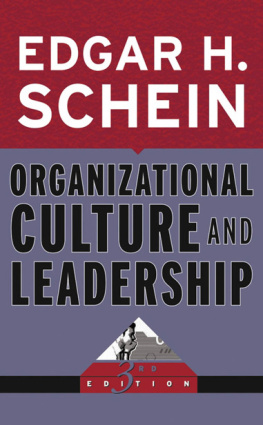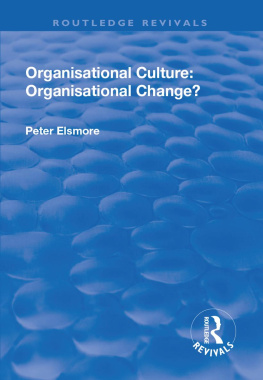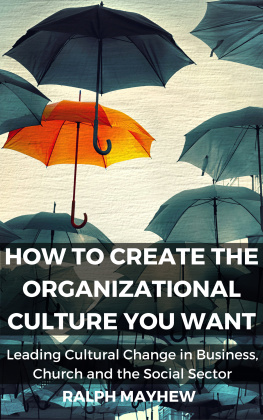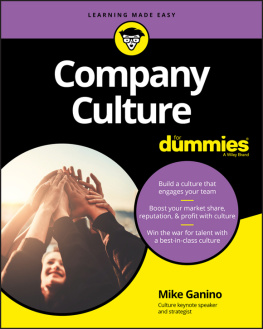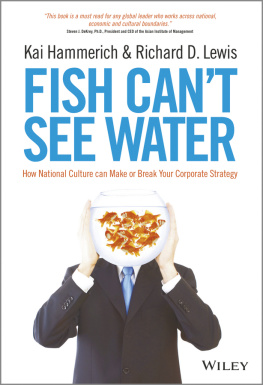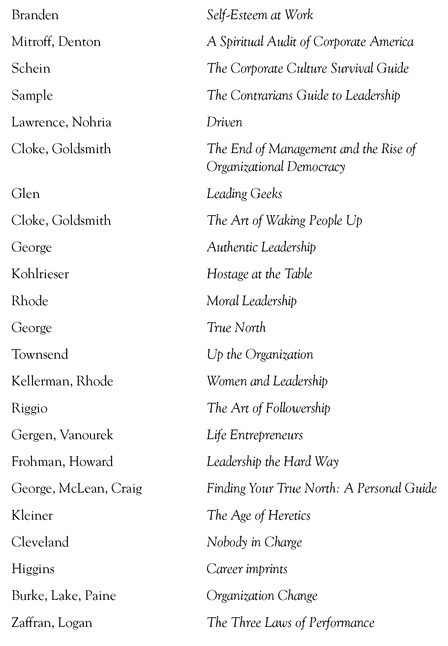Table of Contents
A WARREN BENNIS BOOK
This collection of books is devoted exclusively to new and exemplary contributions to management thought and practice. The books in this series are addressed to thoughtful leaders, executives, and managers of all organizations who are struggling with and committed to responsible change. My hope and goal is to spark new intellectual capital by sharing ideas positioned at an angle to conventional thoughtin short, to publish books that disturb the present in the service of a better future.
Books in the Warren Bennis Signature Series
Preface to the New and Revised Edition
The field of organizational culture has evolved along several dimensions in the ten years since the first edition of this book. This new and revised edition attempts to capture this evolution while retaining the fundamental model of culture that continues to prove to be a useful tool. My basic model of organizational culture has not changed, but the application of the model has certainly changed both research and practice around culture formation, evolution, and managed change. I am still addressing the practicing leader and manager who wants to understand and work with culture. To that end the basic structure of the book will look similar to the first edition.
Culture as a concept in organizational life has come to be accepted, but there is still a strong divide between (1) those who want very abstract universal dimensions of culture that can be measured with surveys and questionnaires and (2) those who want to study the nuances, details, and dynamics of particular cultures by observation, interview, and intervention. The first approach looks for general traits; the second approach looks for general cultural processes.
Both groups are interested in how cultural forces impact organizational performance, but whereas the first group is looking for cultural traits that will correlate with performance across all kinds of companies and industries, the second group is looking for direct linkages between particular cultural events and performance outcomes. The first approach lends itself to a quantitative cross-sectional analysis, the second requires a more clinical longitudinal analysis. The first approach of necessity develops variables that are quite abstract and removed from here-and-now organizational events that the manager or consultant encounters in a particular company. The second approach looks for proximate variables that enable the manager or consultant to deal with the immediate situation. The first approach tries to develop broad theoretical principles that apply to large numbers of organizations. The second approach looks for middle-level theories that illuminate local situations.
I have chosen to highlight this difference at the outset in order to make it very clear to the reader what my own position is on this dimension. While I gain some insight from the work of colleagues who work on the first approach, I have found that my own insights are far greater if I am clinically involved as an active change agent. I have come to believe that at this stage of the development of our field we still need the detailed clinical studies of cultural events because we do not yet know what the crucial dimensions and variables will ultimately turn out to be.
There is also a more pressing argument for the second approach. One cannot really build, evolve, or change culture without getting into the messy details of particular cultures. The broad dimensions are valid, but they are so distant from the day-to-day phenomena that leaders and managers are wrestling with that they do not inform you on what should be done.
So this book, especially this new and revised edition, is written to the leader and manager who needs to get something done and, therefore, needs to understand the nitty gritty of culture dynamics. As it turns out, this nitty gritty has become much more complex because of the evolution of technological complexity, leading to more occupational subcultures, and the growth of globalism, leading to more groups and organizations that mix both occupational and national cultures. A merger of two companies in one country is a far different set of issues than a joint venture of two different companies from two different countries trying to put together a project in yet another country.
Leaders and managers of organizations (and societies) are creators, products, and victims of culture. And it is one of the unique functions of leadership not only to create cultures in new groups but also to manage cultural issues in mature organizations. For all of this, they need concepts and a toolkit. This book is written from that point of view. It is intended to explain what culture is, when and how one assesses it, and when and how one changes it.
The basic structure is similar to the previous edition. In Part One we examine basic definitions, why culture is important in the first place, and what range of dimensions can be explored in probing the content of culture. Part Two begins with an important chapter on general change theory and how it applies to culture. In the next three chapters I explain how to work with culture at different stages of organizational evolution. Finally, we end with the very new issue of multicultural groups that more or less start from scratch to blend together to the extent possible the different assumptions that are brought to a new project by members from different cultures. This is as yet uncharted territory but some principles of how to blend cultures are beginning to emerge.
Acknowledgements
My main debt is once again to my clients, who not only provided endlessly interesting and challenging culture puzzles but whose efforts to evolve and change culture revealed many of the crucial dynamics that have informed the content of this book. Whenever possible I have named these clients, but in some projects confidentially was requested so I gave them pseudonyms.
I am very appreciative of the thoughtful and detailed reviews of my first edition that were provided by the Jossey-Bass editorial staff and want to express a special thank you to Joan Gallos, who was helpful as a reviewer and, more importantly, as a guide through the complexity of the reviews themselves.
Ed Schein
Cambridge, MA
January 2009
The Author
Ed Schein is the Sloan Fellows Professor of Management Emeritus at the MIT Sloan School of Management. He received his Ph.D. in social psychology from Harvard in 1952, worked at the Walter Reed Institute of Research for four years, and then joined MIT, where he taught until 2005. He has published extensively in organizational psychology (Organizational Psychology, 3rd ed., 1980), process consultation (Process Consultation Revisited, 1999), career dynamics (Career Anchors, 3rd ed., 2006), organizational culture texts (Organizational Culture and Leadership, 3rd ed., 2004), analyses of Singapores economic miracle (


